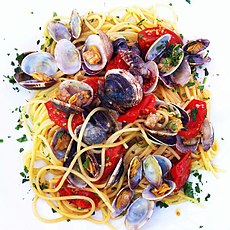Tuscan cuisine
 |
| Italian cuisine |
|---|
|
|

Tuscan cuisine refers to the culinary traditions of the Tuscan region in Italy celebrated for its simplicity and focus on fresh, high-quality ingredients like olive oil, legumes, and meats. Rooted in cucina povera (Italian for 'cuisine of the poor'), it emphasizes seasonal ingredients and straightforward flavors over complex sauces and spices.[1]
Tuscany is also home to some of the most famous wines in the world such as Chianti, Brunello di Montalcino, and Vino Nobile di Montepulciano.[2]
Bread plays a very important role in Tuscan cuisine. One specialty of Tuscan cuisine is a white, plain, unsalted bread. This bread accompanies all foods. This bread has its origin in the 16th century when salt was heavily taxed.[3]
History
[edit]
Tuscan cuisine is a blend of Etruscan and Roman cooking traditions. The Etruscans, who inhabited the region before the rise of Rome, were skilled in viticulture, cultivating grapes and producing their own wines. They also foraged for truffles, an ingredient that became a prized element in their cooking.[4][5]
The foundations of Tuscan cuisine began to take shape during the Renaissance, particularly under the influence of the Medici family. The Medici not only elevated the quality and sophistication of Tuscan food but also impacted French cuisine through Catherine de' Medici, who brought Tuscan culinary techniques and ingredients to France when she married King Henry II.[4]
In Tuscany's countryside, the tradition of "riuso" developed, driven by the philosophy of "not throwing anything away." This approach led to a resourceful use of ingredients, inspiring iconic dishes like ribollita and panzanella, which transform simple, leftover ingredients into hearty meals.[6]
Breads
[edit]- Pane di patate della Garfagnana
- Pane sciocco
- Pane Toscano
Dishes
[edit]- Bistecca alla fiorentina
- Acquacotta
- Agnellotti
- Ribollita
- Panzanella
Cured meats
[edit]- Prosciutto toscano
- Pancetta
- Capocollo
Desserts
[edit]- Torta della nonna
- Necci
- Bolli livornesi
- Panforte
Wines
[edit]See also
[edit]- Italian cuisine
- Sicilian cuisine
- Italian wines
- Tuscan wines
- Mediterranean cuisine
- Roman cuisine
- Cuisine of Basilicata
References
[edit]- ^ "La Cucina Povera: The Poor Cuisine of Tuscany". Italy Segreta. 2022-01-15. Retrieved 2024-11-03.
- ^ "Vini toscani: i 10 più famosi Alla scoperta dei 10 vini più conosciuti e apprezzati della Toscana Corte Dei Venti". www.lacortedeiventi.it (in Italian). Retrieved 2024-11-03.
- ^ "Tuscan Cuisine: A Culinary Journey Through the Heart of Italy". www.discovertuscany.com. Retrieved 2024-11-03.
- ^ a b Spiegel, Jessica (2022-03-01). "Tuscan Culinary History: A Complete Deep Dive". Devour Tours. Retrieved 2024-11-03.
- ^ "Tuscan Cooking". galileo.rice.edu. Retrieved 2024-11-03.
- ^ "La cucina toscana delle origini, la cucina del "riuso"". tuttatoscana (in Italian). 2022-01-09. Retrieved 2024-11-03.
Sources
[edit]- Chrzan, Janet A. (2008). "Culinary Tourism in Tuscany: Media Fantasies, Imagined Traditions and Transformative Travel". In Lysaght, Patricia (ed.). Tourism and Museum: Sanitas per Aquas, Spas, Lifestyles and Foodways. Innsbruck: StudienVerlag. pp. 235–251.
